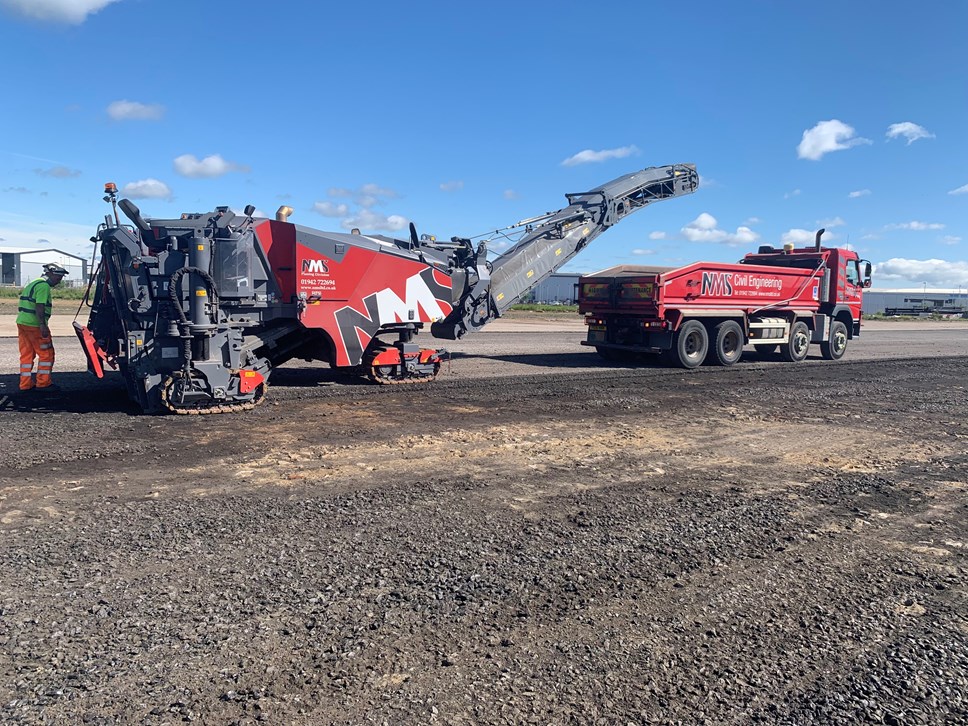
Historic Samlesbury Aerodrome runway begins a new life on our roads
One of the old runways at the former Samlesbury Aerodrome is being given a new lease of life on Lancashire's roads thanks to a unique recycling scheme being led by the county council.
The huge expanse of asphalt, previously part of BAE Systems Samlesbury site, has been the testbed for dozens of cutting-edge aircraft since the 1940s, and is currently being dug up as part of preparation work for the expanding Samlesbury Enterprise Zone, which aims to provide a home for high-tech jobs and businesses of the future.
But rather than simply disposing of the old asphalt, the county council is working with highway industry experts to process part of the runway into a new material which is being used to resurface rural roads, helping to protect drivers and cyclists from potholes, and reduce CO2 emissions. Using the recycled asphalt reduces CO2 output by around one third compared with using new material.
Around 17,000 tonnes of this recycled material will have been used to resurface roads in Burnley, Pendle, Ribble Valley, Rossendale, and Wyre this summer. Any remaining material is planned to be used to maintain roads as part of the county council's annual capital programme. The recycling operation is due to be finished by October so that redevelopment of the Samlesbury Enterprise Zone site can progress.
County Councillor Rupert Swarbrick, Lancashire County Council cabinet member for highways and transport, said: "The Samlesbury Aerodrome has been the birthplace for decades of technological innovation, and I'm very pleased that we're playing our own part in this as we prepare for future construction at the Samlesbury Enterprise Zone, which will secure the future of high-tech industry at this site.
"We're increasingly taking advantage of developments in the highways industry such as the availability of recycled asphalt to reduce the environmental impact of maintaining our roads. As well as helping to cut our carbon footprint, we no longer have the waste, and cost, of disposing of the old road surface.
"Another real positive with this scheme is that, due to the sheer size of the old runway, we're using a special machine to recycle the material directly at Samlesbury before taking it straight to the sites where it will be used to resurface our roads, significantly cutting the road miles which would otherwise be travelled to process it beforehand."
Hannah Swindell, Head of Sustainability at BAE Systems Air, added: "We were delighted to support activities such as this which help reduce the environmental impact on our communities. Like Lancashire County Council, we are committed to driving down our carbon emissions and helping the drive towards net zero, and being able to support this activity is just a small example of that in action."
The runway at Samlesbury has played a key role in the development of dozens of cutting-edge aircraft since the aerodrome was established in the 1940s. The first aircraft wholly designed and built at the site was the English Electric Canberra which saw its maiden flight in 1949. The iconic English Electric Lightning was also built at Samlesbury, though most of the Lightnings only did their first flights from the site, this being a 'hop' to Warton with a partial fuel load - Samlesbury’s runway being considered too short for regular Lightning flying.
County Councillor Shaun Turner, Lancashire County Council cabinet member for environment and climate change, said: "It's very fitting that we're continuing the proud history of leading-edge technology being employed at Samlesbury even as we remove the old infrastructure to lay the ground for the Samlesbury Enterprise Zone.
"The purpose of the Enterprise Zone is to bring together a cluster of businesses with expertise in cyber, robotics, research and development, and advanced manufacturing, providing the opportunity for them to collaborate and grow even more strongly by being in close proximity to each other, and BAE Systems.
"There continues to be strong interest from potential occupiers in coming to Samlesbury and we are currently working with them to understand their accommodation requirements and secure their future at this exciting and developing site."
The recycled material being made for use on the roads is used to form an initial base layer, with the final 'surface course' being laid on top of this.
The county council's investment at Samlesbury Enterprise Zone is essential to Lancashire’s emerging long-term strategy, Lancashire 2050, and also supports both the county’s post Covid-19 recovery and the government’s Levelling Up agenda.
Notes to editors
Please get in touch if you would like the video as a file rather than a link.
Pictures show:
The runway being planed off to be recycled
The material being used to resurface Burnley Road in Rawtenstall
(L-R) County Councillor Rupert Swarbrick and County Councillor Shaun Turner
The recycled material has been used for resurfacing schemes on the following roads this summer:
Burnley - Crown Point Road
Pendle - Pasture Lane, Barrowford; Keighley Road, Trawden; and M65, Jct 13, Nelson
Ribble Valley - Gisburn Road and Smalden Lane in Bolton by Bowland; Worston Road, Clitheroe; and Howgill Lane, Rimington
Rossendale – Burnley Road and the Rawtenstall Spur (A682)
Wyre - Woods Lane, Inskip, and Sandy Lane, Preesall
